Niger
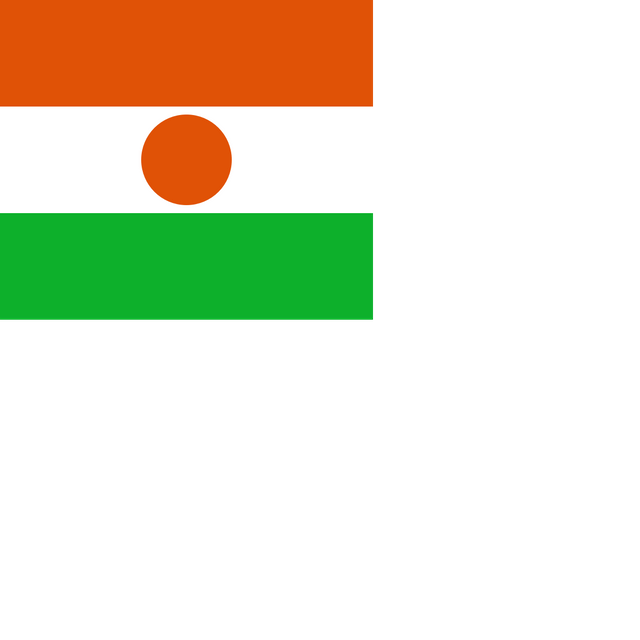
Niger

| Capital | Niamey |
|---|---|
| Official languages | French |
| National languages[1] | |
| Demonym(s) | Nigerien( or ) |
| Government | Unitarysemi-presidential republic |
| Mahamadou Issoufou | |
| Brigi Rafini | |
| Legislature | National Assembly |
| Independence | |
| 3 August 1960 | |
| Area | |
| 1,267,000 km (489,000 sq mi) (21st) | |
| 0.02 | |
| Population | |
| 20,672,987 (61st) | |
| 17,138,707 | |
| 12.1/km (31.3/sq mi) | |
| GDP | 2018 estimate |
| $23.475 billion[4](140th) | |
| $1,213[5](183rd) | |
| GDP | 2018 estimate |
| $9.869 billion[4](136th) | |
| $510 | |
| Gini | |
| HDI | |
| Currency | West African CFA franc(XOF) |
| Time zone | (WAT) |
| Driving side | right[10] |
| Calling code | +227 |
| ISO 3166 code | NE |
| Internet TLD | .ne |
Niger or the Niger [11][12] (/niːˈʒɛər/ or /ˈnaɪdʒər/;[13][3] French: [niʒɛʁ]), officially the Republic of the Niger,[11][12] is a landlocked country in West Africa named after the Niger River. Niger is bordered by Libya to the northeast, Chad to the east, Nigeria to the south, Benin to the southwest, Burkina Faso and Mali to the west, and Algeria to the northwest. Niger covers a land area of almost 1,270,000 km2 (490,000 sq mi), making it the largest country in West Africa. Over 80% of its land area lies in the Sahara Desert. The country's predominantly Islamic population of about 21 million[15] live mostly in clusters in the far south and west of the country. The capital and largest city is Niamey, located in Niger's southwest corner.
Niger is a developing country, which consistently ranks near the bottom in the United Nations' Human Development Index (HDI); it was ranked 187th of 188 countries for 2015 and 189th out of 189 countries in the 2018 report.[9] Many of the non-desert portions of the country are threatened by periodic drought and desertification. The economy is concentrated around subsistence, with some export agriculture in the more fertile south, and export of raw materials, especially uranium ore. Niger faces serious challenges to development due to its landlocked position, desert terrain, inefficient agriculture, high fertility rates without birth control, and the resulting overpopulation,[17] the poor educational level and poverty of its people, lack of infrastructure, poor healthcare, and environmental degradation.
Nigerien society reflects a diversity drawn from the long independent histories of its several ethnic groups and regions and their relatively short period living in a single state. Historically, what is now Niger has been on the fringes of several large states. Since independence, Nigeriens have lived under five constitutions and three periods of military rule. After the military coup in 2010, Niger became a democratic, multi-party state. A majority of the population lives in rural areas, and has little access to advanced education.
| Capital | Niamey |
|---|---|
| Official languages | French |
| National languages[1] | |
| Demonym(s) | Nigerien( or ) |
| Government | Unitarysemi-presidential republic |
| Mahamadou Issoufou | |
| Brigi Rafini | |
| Legislature | National Assembly |
| Independence | |
| 3 August 1960 | |
| Area | |
| 1,267,000 km (489,000 sq mi) (21st) | |
| 0.02 | |
| Population | |
| 20,672,987 (61st) | |
| 17,138,707 | |
| 12.1/km (31.3/sq mi) | |
| GDP | 2018 estimate |
| $23.475 billion[4](140th) | |
| $1,213[5](183rd) | |
| GDP | 2018 estimate |
| $9.869 billion[4](136th) | |
| $510 | |
| Gini | |
| HDI | |
| Currency | West African CFA franc(XOF) |
| Time zone | (WAT) |
| Driving side | right[10] |
| Calling code | +227 |
| ISO 3166 code | NE |
| Internet TLD | .ne |
History
Prehistory
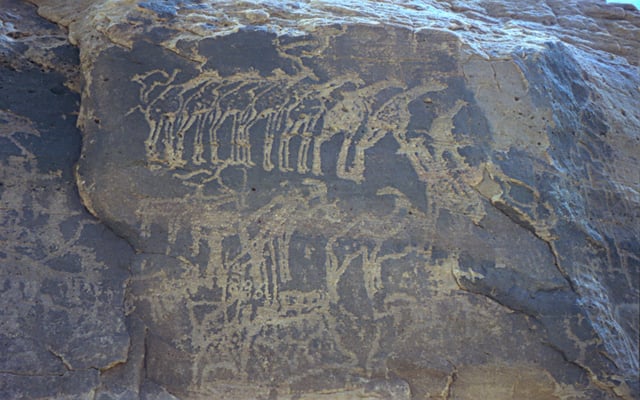
Ancient rock engraving showing herds of giraffe, ibex, and other animals in the southern Sahara near Tiguidit, Niger.
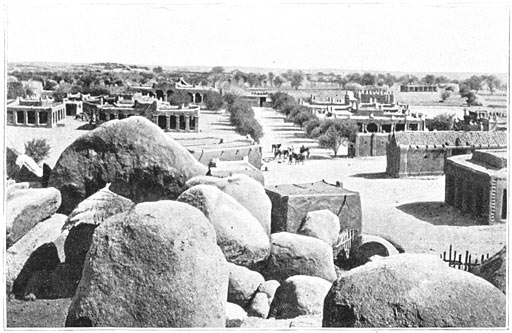
Overlooking the town of Zinder and the Sultan's Palace from the French fort (1906). The arrival of the French spelled a sudden end for precolonial states like the Sultanate of Damagaram, which carried on only as ceremonial "chiefs" appointed by the colonial government.
Early human settlement in Niger is evidenced by numerous archaeological remains.
In prehistoric times, the climate of the Sahara (Ténéré desert in Niger) was wet and provided favorable conditions for agriculture and livestock herding in a fertile grassland environment five thousand years ago.[18]
In 2005–06, a graveyard in the Ténéré desert was discovered by Paul Sereno, a paleontologist from the University of Chicago.[19] His team discovered 5,000-year-old remains of a woman and two children in the Ténéré Desert.[19] The evidence along with remains of animals that do not typically live in desert are among the strongest evidence of the 'green' Sahara in Niger. It is believed that progressive desertification around 5000 BC pushed sedentary populations to the south and south-east (Lake Chad).[20]
Empires and kingdoms in pre-colonial Niger
By at least the 5th century BC, Niger had become an area of trans-Saharan trade, led by the Berber tribes from the north, who used camels as a well-adapted means of transportation through the desert.
This trade made Agadez a pivotal place of the trans-Saharan trade. This mobility, which would continue in waves for several centuries, was accompanied with further migration to the south and intermixing between sub-Saharan African and North African populations. It was also aided by the introduction of Islam to the region at the end of the 7th century.[20] Several empires and kingdoms also flourished during this era, up to the beginning of colonization in Africa.
Songhai Empire (600–1591)
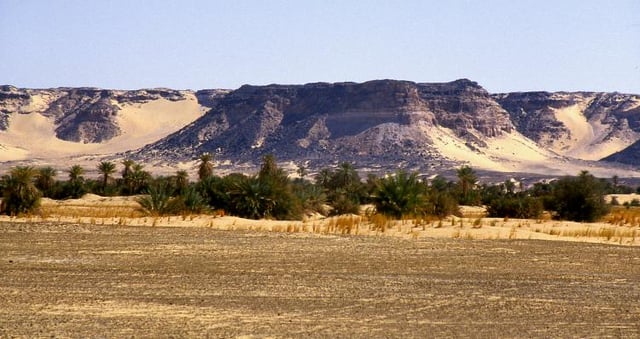
The Kaouar escarpment, forming an oasis in the Ténéré desert.
The Songhai Empire was an empire bearing the name of its main ethnic group, the Songhai or Sonrai, located in western Africa on the bend of the Niger River in present-day Niger, Mali and Burkina Faso. In the 7th century, Songhai tribes settled down north of modern-day Niamey and founded the Songhai city-states of Koukia and Gao. By the 11th century, Gao had become the capital of the Songhai Empire.[21]
From 1000 to 1325, The Songhai Empire prospered and managed to maintain peace with its neighboring empires including the Mali Empire. In 1325 the Songhai Empire was conquered by the Mali Empire but was freed in 1335 by prince Ali Kolen and his brother, Songhai princes held captive by Moussa Kankan, the ruler of the Mali Empire.[21] From the mid-15th to the late 16th century, Songhai was one of the largest Islamic empires in history.[22]
Hausa kingdoms (mid-14th century – 1808)
Between the Niger River and Lake Chad lay Hausa kingdoms and fertile areas. These kingdoms flourished from the mid-14th century up until the early 19th century, when they were conquered by Usman dan Fodio, founder of the Sokoto Empire. The Hausa kingdoms were not a compact entity but several federations of kingdoms more or less independent of one other. Their organization was somewhat democratic: the Hausa kings were elected by the notables of the country and could be removed by them.[21]
The Hausa Kingdoms began as seven states founded according to the Bayajidda legend by the six sons of Bawo. Bawo was the only son of the Hausa queen Daurama and Bayajidda or (Abu Yazid according to certain Nigerien historians) who came from Baghdad. The seven original Hausa states were: Daoura (state of queen Daurama), Kano, Rano, Zaria, Gobir, Katsena and Biram.[21]
Mali Empire
The Mali Empire was a Mandinka empire founded by Sundiata Keita circa 1230 that existed up to 1600. At its peak circa 1350, the empire extended as far west as Senegal and Guinee Conakry and as far east as western Niger.
Kanem-Bornu Empire
The Kanem-Bornu Empire was an empire that existed in modern-day Chad, Nigeria, Cameroon, Niger and Libya.
The empire first existed and prospered as the Kanem Empire as early as the 9th century and later as the Kingdom of Bornu until 1900.
French Niger (1900–58)
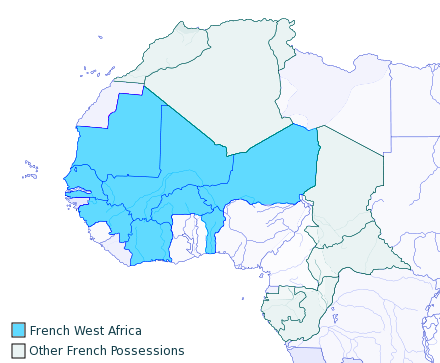
Map of French West Africa, circa 1913
In the 19th century, contact with Europe began with the first European explorers—notably Monteil (French) and Barth (German)—to travel to Niger.
Following the 1885 Berlin conference during which colonial powers outlined the division of Africa into colonial spheres, French military efforts to conquer existing African states were intensified in all French colonies including Niger. This included several military expeditions including the Voulet Chanoine Mission, which became notorious for pillaging, looting, raping and killing many local civilians on its passage. On 8 May 1899, in retaliation for the resistance of queen Sarraounia, captain Voulet and his men murdered all the inhabitants of the village of Birni-N'Konni in what is regarded as one of the worst massacres in French colonial history. French military expeditions met great resistance from several ethnic groups, especially Hausa and Tuareg groups. The most notable Tuareg revolt was the Kaocen Revolt. The French authorities also abolished the widespread slavery among Tuareg communities.
By 1922, all resistance to colonial rule was eliminated and Niger became a French colony. Niger's colonial history and development parallel that of other French West African territories. France administered her West African colonies through a governor general at Dakar, Senegal, and governors in the individual territories, including Niger. In addition to conferring a limited form of French citizenship on the inhabitants of the territories, the 1946 French constitution provided for decentralization of power and limited participation in political life for local advisory assemblies.
The end of the colonial era was characterized by a transformation of the political environment in French West Africa and Niger.
The Nigerien Progressive Party, the Nigerien section of the African Democratic Rally Party, founded in May 1946, united various tendencies of Nigerien people in the movement for national independence.
In alliance with progressive French elements and other independence African movements, the movements acquired the suppression of forced labor and arbitrary requisitions as well as legal equality between the African and the French citizens.
Independence (1958)
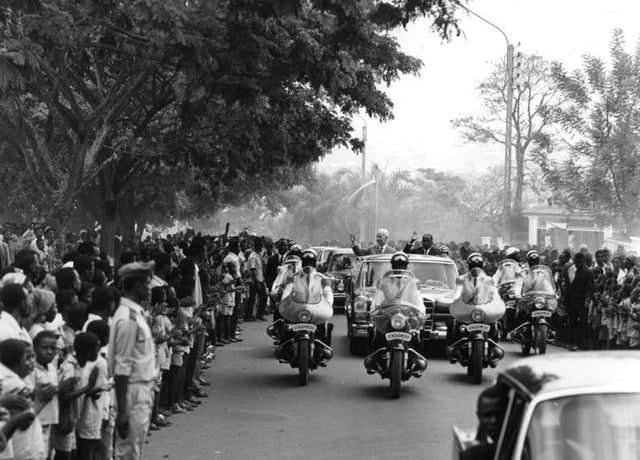
President Hamani Diori and visiting German President Dr. Heinrich Lübke greet crowds on a state visit to Niamey, 1969. Diori's single party rule was characterized by good relations with the west and a preoccupation with foreign affairs.
Following the Overseas Reform Act (Loi Cadre) of 23 July 1956 and the establishment of the Fifth French Republic on 4 December 1958, Niger became an autonomous state within the French Community. On 18 December 1958, the Republic of Niger was officially created with Hamani Diori as the head of the Counsel of Ministers of the Republic of Niger. On 11 July 1960, Niger decided to leave the French Community and acquired full independence on 3 August 1960 with Diori as its first president.
For its first fourteen years as an independent state, Niger was run by a single-party civilian regime under the presidency of Diori.
In 1974, a combination of devastating drought and accusations of rampant corruption resulted in a coup d'état that overthrew the Diori regime.
First military regime: The Supreme Military Council and Second Republic 1974–1991
Col. Seyni Kountché and a small military group under the name of Supreme Military Council deposed Diori in April 1974, following a military coup, the first of many in the post-colonial history of Niger. President Kountché ruled the country until his death in 1987.[23]
The first action of the Kountché military government was to address the food crisis which was one of the catalysts of the military coup.[24] While political prisoners of the Diori regime were released after the coup and the country was stabilized, political and individual freedom deteriorated in general during this period.
Political parties were banned.
Several attempted coups (1975, 1976 and 1983) were thwarted and authors and associates were severely punished.
Despite the restriction in freedom, the country enjoyed improved economic development with the creation of new companies, the construction of major infrastructure (building and new roads, schools, health centers) and minimal corruption in government agencies, which Kountché did not hesitate to punish severely.[25] This economic development was helped by the uranium boom as well as optimal usage of public funds.
Kountché was succeeded by his Chief of Staff, Col. Ali Saibou, who was confirmed as Chief of the Supreme Military Council on 14 November 1987, four days after Kountché's death. He introduced political reforms and drafted a new constitution, with the creation of a single party. He went on to rule the country as the Chief of the Supreme Military Council.
The 1989 referendum led to the adoption a new constitution and the creation of the Second Republic of Niger.
General Saibou became the first president of the Second Republic after winning the presidential election on 10 December 1989.
His presidency started during the Second Republic largely following his efforts at the end of the previous military regime with attempts at normalizing the political situation in the country with the release of political prisoners, liberalization of laws and policies.
President Saibou's efforts to control political reforms failed in the face of trade union and student demands to institute a multi-party democratic system. On 9 February 1990, a violently repressed student march led to the death of three students,[26] which led to increased national and international pressure for a National Conference. The Saibou regime acquiesced to these demands by the end of 1990.
National Conference and Third Republic 1991–1997
The National Sovereign Conference of 1991 marked a turning point in the post-independence era of Niger and brought about multi-party democracy.
From 29 July to 3 November, a national conference gathered all fringes of society to examine the political, economic and social situation of the country and make recommendations for the future direction of the country.
The conference was presided over by Prof. André Salifou and developed a plan for a transitional government. This transitional government was installed in November 1991 to manage the affairs of state until the institutions of the Third Republic were put into place in April 1993.
While the economy deteriorated over the course of the transition, there were certain notable accomplishments, including the successful conduct of a constitutional referendum; the adoption of key legislation such as the electoral and rural codes; and the holding of several free, fair, and non-violent nationwide elections.
Freedom of the press flourished, with the appearance of several new independent newspapers.
After the National Sovereign Conference, the transitional government drafted a new constitution that eliminated the previous single-party system of the 1989 Constitution and guaranteed more freedom.
The new constitution was adopted by a referendum on 26 December 1992.
Following this, presidential elections were held and Mahamane Ousmane became the first president of the Third Republic on 27 March 1993. The presidency of Mahamane Ousmane was characterized by political turbulence, with four government changes and early legislative elections called in 1995.
The parliamentary election forced cohabitation between a rival president and prime minister and ultimately led to governmental paralysis. As part of an initiative started under the National Sovereign Conference the government signed peace accords in April 1995 with Tuareg and Toubou groups that had been in rebellion since 1990. These groups claimed they lacked attention and resources from the central government. The government agreed to absorb some of the former rebels into the military and, with French assistance, to help others return to a productive civilian life.[27]
Second military regime, Fourth Republic, third military regime 1997–1999
The government paralysis and the political tension was used as a motivation for a second military coup.
On 27 January 1996, Col. Ibrahim Baré Maïnassara led a military coup that deposed President Ousmane and ended the Third Republic. Col. Maïnassara created the National Salvation Council composed of military officials, which he headed. The Council carried out a six-month transition period during which a new constitution was drafted and adopted on 12 May 1996.
Presidential campaigns were organized in the months that followed.
General Maïnassara entered the campaign as an independent candidate and won the election on 8 July 1996.
The elections were viewed nationally and internationally as irregular since the electoral commission was replaced during the campaign.
Ibrahim Baré Maïnassara became the first president of the Fourth Republic.
His efforts to justify questionable elections failed to convince donors to restore multilateral and bilateral economic assistance; a desperate Maïnassara ignored an international embargo against Libya and sought Libyan funds to aid Niger's economy. In repeated violations of basic civil liberties by the regime, opposition leaders were imprisoned and journalists often arrested, and deported by an unofficial militia composed of police and military.
On 9 April 1999, Maïnassara was assassinated during a military coup led by Maj. Daouda Malam Wanké, who established a transitional National Reconciliation Council to oversee the drafting of a constitution for the Fifth Republic with a French-style semi-presidential system. The new constitution was adopted on 9 August 1999 and was followed by presidential and legislative elections in October and November of the same year. The elections were generally found to be free and fair by international observers. Wanké withdrew himself from government affairs after the new and democratically elected president was sworn in office.
Fifth republic 1999–2009
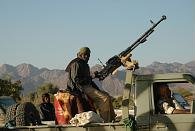
A Tuareg rebel fighter in northern Niger, 2008
After winning the election in November 1999, President Tandja Mamadou was sworn in office on 22 December 1999 as the first president of the Fifth Republic. The first mandate of Tandja Mamadou brought about many administrative and economic reforms that had been halted due to the military coups since the Third Republic. In August 2002, serious unrest within military camps occurred in Niamey, Diffa, and Nguigmi, but the government was able to restore order within several days. On 24 July 2004, the first municipal elections in the history of Niger were held to elect local representatives, previously appointed by the government. These elections were followed by presidential elections. President Tandja Mamadou was re-elected for a second term, thus becoming the first president of the republic to win consecutive elections without being deposed by military coups. The legislative and executive configuration remained quite similar to that of the first term of the President: Hama Amadou was reappointed as Prime Minister and Mahamane Ousmane, the head of the CDS party, was re-elected as the President of the National Assembly (parliament) by his peers.
By 2007, the relationship between President Tandja Mamadou and his prime minister had deteriorated, leading to the replacement of the latter in June 2007 by Seyni Oumarou following a successful vote of no confidence at the Assembly. From 2007 to 2008, the Second Tuareg Rebellion took place in northern Niger, worsening economic prospects at a time of political limited progress. The political environment worsened in the following year as President Tandja Mamadou sought out to extend his presidency by modifying the constitution which limited presidential terms in Niger. Proponents of the extended presidency, rallied behind the Tazartche movement, were countered by opponents (anti-Tazartche) composed of opposition party militants and civil society activists.
Sixth republic and fourth military regime 2009–2010
In 2009, President Tandja Mamadou decided to organize a constitutional referendum seeking to extend his presidency claiming to respond to the desire of the people of Niger.
Despite opposition from opposition political parties and against the decision of the Constitutional Court which ruled earlier that the referendum would be unconstitutional, President Tandja Mamadou modified and adopted a new constitution by referendum.
It was declared illegal by the Constitutional Court but the President dissolved the Court and assumed emergency powers.
The opposition boycotted the referendum and the new constitution was adopted with 92.5% of voters and a 68% turnout, according to official results.
The adoption of the new constitution created a Sixth Republic, with a presidential system, as well as the suspension of the 1999 Constitution and a three-year interim government with Tandja Mamadou as president. Political and social unrest spiraled before, during and after the referendum project and ultimately led to a military coup in 2010 that ended the brief existence of the 6th Republic.
In a February 2010 coup d'état, a military junta led by captain Salou Djibo was established in response to Tandja's attempted extension of his political term by modifying the constitution. The Supreme Council for the Restoration of Democracy led by General Salou Djibo carried out a one-year transition plan, drafted a new constitution and held elections in 2011 that were judged internationally as free and fair.
Seventh republic 2010–present
Following the adoption of the newest constitution of 2010 and the presidential elections, Mahamadou Issoufou was elected as the first president of the Seventh Republic.
Geography, climate, and ecology
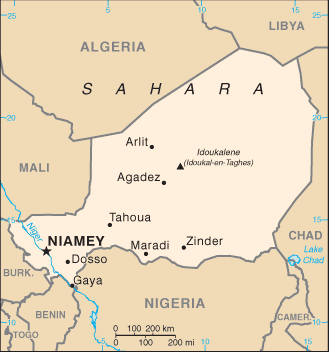
A map of Niger
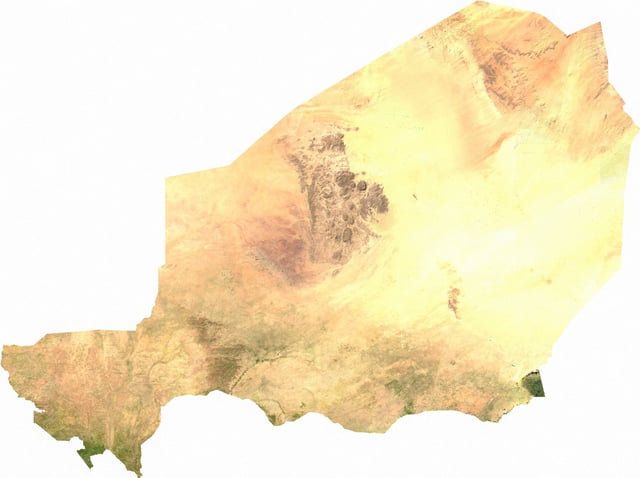
Satellite image of Niger
Niger is a landlocked nation in West Africa located along the border between the Sahara and Sub-Saharan regions. It borders Nigeria and Benin to the south, Burkina Faso and Mali to the west, Algeria and Libya to the north and Chad to the east.
Niger borders seven countries and has a total perimeter of 5,697 kilometres (3,540 mi). The longest border is with Nigeria to the south (1,497 km or 930 mi). This is followed by Chad to the east, at 1,175 km (730 mi), Algeria to the north-northwest (956 km or 594 mi), and Mali at 821 km (510 mi). Niger also has small borders in its far southwest with Burkina Faso at 628 km (390 mi) and Benin at 266 km (165 mi) and to the north-northeast Libya at 354 km (220 mi).
The lowest point is the Niger River, with an elevation of 200 metres (656 ft). The highest point is Mont Idoukal-n-Taghès in the Aïr Mountains at 2,022 m (6,634 ft).
Climate

Niger map of Köppen climate classification.
Niger's subtropical climate is mainly very hot and very dry, with much desert area. In the extreme south there is a tropical climate on the edges of the Niger River basin. The terrain is predominantly desert plains and sand dunes, with flat to rolling savanna in the south and hills in the north.
Environment

An elephant in the W National Park.
The north of Niger is covered by large deserts and semi deserts.
The typical mammal fauna consists of Addax antelopes, Scimitar-horned oryx, gazelles and in mountains Barbary sheep. One of the largest reserves of the world, the Aïr and Ténéré National Nature Reserve, was founded in the northern parts of the Niger to protect these rare species.
The southern parts of Niger are naturally dominated savannahs.
The W National Park, situated in the bordering area to Burkina Faso and Benin, belongs to one of the most important areas for wildlife in Western Africa, which is called the WAP (W–Arli–Pendjari) Complex. It has the most important population of the rare West African lion and one of the last populations of the Northwest African cheetah.
Other wildlife includes elephants, buffaloes, roan antelopes, kob antelopes and warthogs. The West African giraffe is currently not found in the W National Park, but further north in Niger, where it has its last relict population.
Environmental issues in Niger include destructive farming practices as a result of population pressure.
Illegal hunting, bush fires in some areas and human encroachment upon the flood plains of the Niger River for paddy cultivation are environmental issues.
Dams constructed on the Niger River in the neighboring countries of Mali and Guinea and also within Niger itself are also cited as a reason for a reduction of water flow in the Niger River—which has a direct effect upon the environment.
A lack of adequate staff to guard wildlife in the parks and reserves is another factor cited for loss of wildlife.[29]
Governance and politics
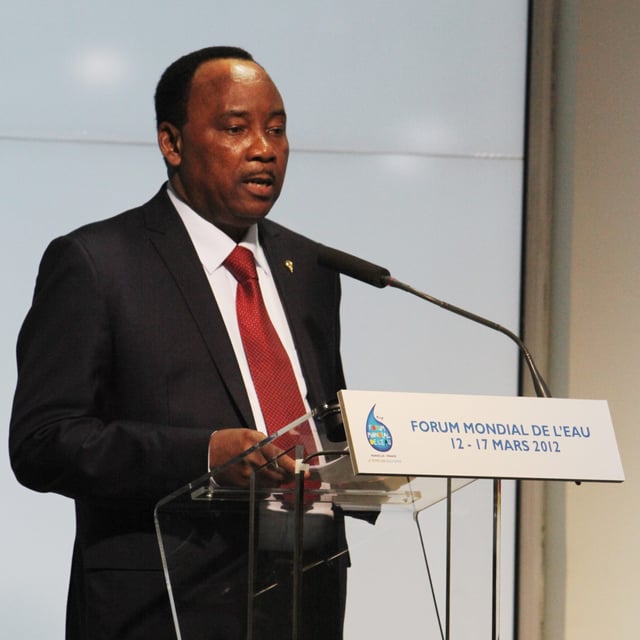
Mahamadou Issoufou, President of Niger.
Niger's new constitution was approved on 31 October 2010.
It restored the semi-presidential system of government of the 1999 constitution (Fifth Republic) in which the president of the republic, elected by universal suffrage for a five-year term, and a prime minister named by the president share executive power.
As a reflection of Niger's increasing population, the unicameral National Assembly was expanded in 2004 to 113 deputies elected for a five-year term under a majority system of representation. Political parties must attain at least 5 percent of the vote in order to gain a seat in the legislature.
The constitution also provides for the popular election of municipal and local officials, and the first-ever successful municipal elections took place on 24 July 2004.
The National Assembly passed in June 2002 a series of decentralization bills.
As a first step, administrative powers will be distributed among 265 communes (local councils); in later stages, regions and departments will be established as decentralized entities.
A new electoral code was adopted to reflect the decentralization context.
The country is currently divided into 8 regions, which are subdivided into 36 districts (departments).
The chief administrator (Governor) in each department is appointed by the government and functions primarily as the local agent of the central authorities.
On 26 May 2009, President Tandja dissolved parliament after the country's constitutional court ruled against plans to hold a referendum on whether to allow him a third term in office.
According to the constitution, a new parliament was elected within three months.[30] This began a political struggle between Tandja, trying to extend his term-limited authority beyond 2009 through the establishment of a Sixth Republic, and his opponents who demanded that he step down at the end of his second term in December 2009.
See 2009 Nigerien constitutional crisis. The military took over the country and President Tandja was put in prison, charged with corruption.
The military kept their promise to return the country to democratic civilian rule.
A constitutional referendum and national elections were held.
A presidential election was held on 31 January 2011, but as no clear winner emerged, run-off elections were held on 12 March 2011.
Mahamadou Issoufou of the Nigerien Party for Democracy and Socialism was elected president. A parliamentary election was held at the same time.[31][32][33]
Foreign relations
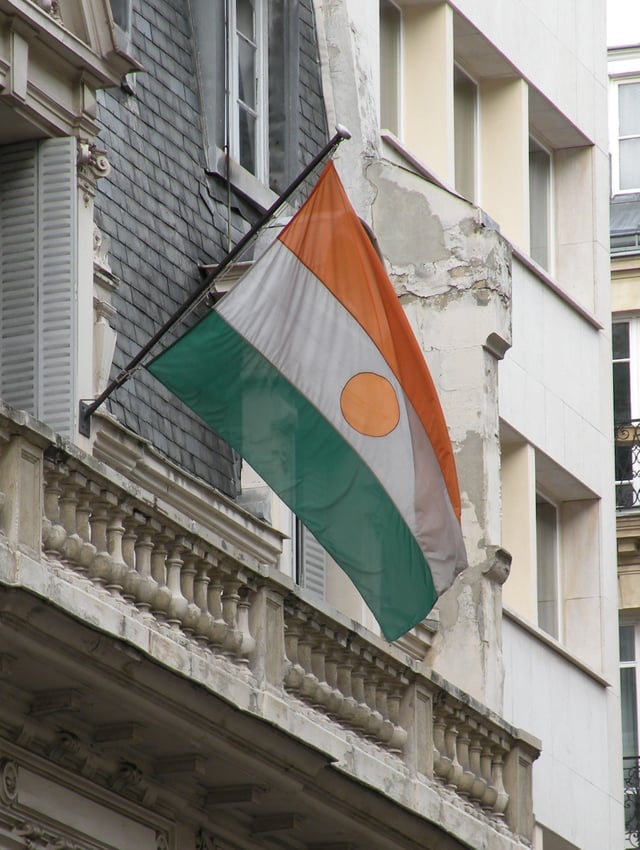
Niger's flag waving at the embassy in Paris.
Niger pursues a moderate foreign policy and maintains friendly relations with the West and the Islamic world as well as non-aligned countries.
It belongs to the UN and its main specialized agencies and in 1980–81 served on the UN Security Council. Niger maintains a special relationship with former colonial power France and has close relations with its West African neighbors.
It is a charter member of the African Union and the West African Monetary Union and also belongs to the Niger Basin Authority and Lake Chad Basin Commission, the Economic Community of West African States, the Non-Aligned Movement, the Organisation of Islamic Cooperation and the Organization for the Harmonization of Business Law in Africa (OHADA). The westernmost regions of Niger are joined with contiguous regions of Mali and Burkina Faso under the Liptako-Gourma Authority.
The border dispute with Benin, inherited from colonial times and concerning inter alia Lété Island in the Niger River, was solved by the International Court of Justice in 2005 to Niger's advantage.
Government finance
Government finance is derived revenue exports (Mining, oil and agricultural exports) as well as various forms of taxes collected by the government.
In the past, foreign aid has contributed to large percentages of the budget.
In 2013, Niger's government has adopted a zero-deficit budget of 1.279 trillion CFA francs ($2.53 billion) which is claimed to balance revenues and expenditures by an 11% reduction in the budget from the previous year.[34]
The 2014 budget was 1.867 trillion CFA which is distributed as follows according to: public debt (76,703,692,000 CFA), personnel expenditures (210,979,633,960 CFA), operating expenditures (128,988,777,711 CFA); subsidies and transfers: 308,379,641,366 CFA) and Investment (1,142,513,658,712 CFA).[35]
Foreign aid
The importance of external support for Niger's development is demonstrated by the fact that about 45% of the government's FY 2002 budget, including 80% of its capital budget, derives from donor resources.[36] The most important donors in Niger are France, the European Union, the World Bank, the International Monetary Fund, and various United Nations agencies (UNDP, UNICEF, FAO, World Food Program, and United Nations Population Fund).
Other principal donors include the United States, Belgium, Germany, Switzerland, Canada, and Saudi Arabia. While USAID does not have an office in Niger, the United States is a major donor, contributing nearly $10 million each year to Niger's development. The U.S. also is a major partner in policy coordination in such areas as food security and HIV/AIDS.
Judicial system
The current Judiciary of Niger was established with the creation of the Fourth Republic in 1999.
The constitution of December 1992 was revised by national referendum on 12 May 1996 and, again, by referendum, revised to the current version on 18 July 1999.
It is based on the Code Napoleon "Inquisitorial system", established in Niger during French colonial rule and the 1960 Constitution of Niger. The Court of Appeals reviews questions of fact and law, while the Supreme Court reviews application of the law and constitutional questions. The High Court of Justice (HCJ) deals with cases involving senior government officials. The justice system also includes civil criminal courts, customary courts, traditional mediation, and a military court.[37] The military court provides the same rights as civil criminal courts; however, customary courts do not. The military court cannot try civilians.[38]
Law enforcement
Law enforcement in Niger is the responsibility of the Ministry of Defense through the National Gendarmerie and the Ministry of the Interior through the National Police and the National Guard. The National Police is primarily responsible for law enforcement in urban areas. Outside big cities and in rural areas, this responsibility falls on the National Gendarmerie and the National Guard.
Military
The Niger Armed Forces (Forces armées nigériennes) are the military and paramilitary forces of Niger, under the president as supreme commander.
They consist of the Niger Army (Armée de Terre), the Niger Air Force (Armée de l'Air) and the auxiliary paramilitary forces, such as the National Gendarmerie (Gendarmerie nationale) and the National Guard (Garde Nationale). Both paramilitary forces are trained in military fashion and have some military responsibilities in wartime. In peace time their duties are mostly policing duties.
The armed forces are composed of approximately 12,900 personnel, including 3,700 gendarmes, 3200 national guards, 300 air force personnel, and 6,000 army personnel. The armed forces of Niger have been involved several military coups over the years with the most recent in 2010. Niger's armed forces have a long history of military cooperation with France and the United States. As of 2013, Niamey is home to a U.S. drone base.
Administrative divisions

Administrative divisions of Niger
Niger is divided into 7 Regions and one capital district. These Regions are subdivided into 36 departments. The 36 Departments are currently broken down into Communes of varying types. As of 2006 there were 265 communes, including communes urbaines (Urban Communes: as subdivisions of major cities), communes rurales (Rural Communes), in sparsely populated areas and postes administratifs (Administrative Posts) for largely uninhabited desert areas or military zones.
Rural communes may contain official villages and settlements, while Urban Communes are divided into quarters.
Niger subvisions were renamed in 2002, in the implementation of a decentralisation project, first begun in 1998.
Previously, Niger was divided into 7 Departments, 36 Arrondissements, and Communes.
These subdivisions were administered by officials appointed by the national government.
These offices will be replaced in the future by democratically elected councils at each level.
The pre-2002 departments (renamed as regions) and capital district are:
Agadez Region
Diffa Region
Dosso Region
Maradi Region
Tahoua Region
Tillabéri Region
Zinder Region
Niamey (capital district)
Largest cities and towns
Economy
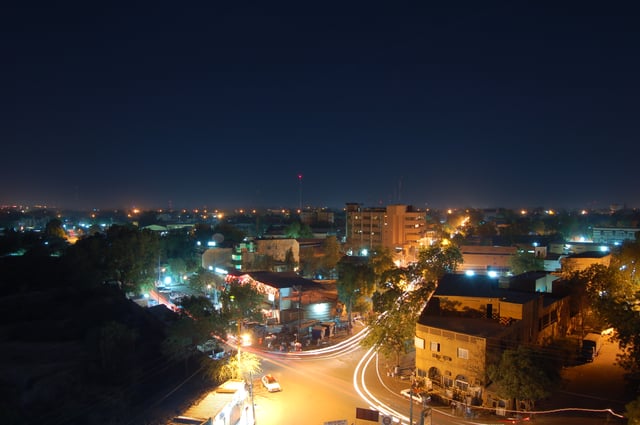
Niamey, Niger's capital and economic hub.
The economy of Niger centers on subsistence crops, livestock, and some of the world's largest uranium deposits.
Drought cycles, desertification, a 2.9% population growth rate, and the drop in world demand for uranium have undercut the economy.
Niger shares a common currency, the CFA franc, and a common central bank, the Central Bank of West African States (BCEAO), with seven other members of the West African Monetary Union. Niger is also a member of the Organization for the Harmonization of Business Law in Africa (OHADA).[40]
In December 2000, Niger qualified for enhanced debt relief under the International Monetary Fund program for Heavily Indebted Poor Countries (HIPC) and concluded an agreement with the Fund for Poverty Reduction and Growth Facility (PRGF). Debt relief provided under the enhanced HIPC initiative significantly reduces Niger's annual debt service obligations, freeing funds for expenditures on basic health care, primary education, HIV/AIDS prevention, rural infrastructure, and other programs geared at poverty reduction.
In December 2005, it was announced that Niger had received 100% multilateral debt relief from the IMF, which translates into the forgiveness of approximately US$86 million in debts to the IMF, excluding the remaining assistance under HIPC. Nearly half of the government's budget is derived from foreign donor resources. Future growth may be sustained by exploitation of oil, gold, coal, and other mineral resources. Uranium prices have recovered somewhat in the last few years. A drought and locust infestation in 2005 led to food shortages for as many as 2.5 million Nigeriens.
Society
Demographics

Fulani women with traditional facial tattoos.
| Year | Million |
|---|---|
| 1950 | 2.5 |
| 2000 | 11.3 |
| 2016 | 20.7 |
Ethnic groups
Languages
French, inherited from the colonial period, is the official language. It is spoken mainly as a second language by people who have received a formal western education and serves as the administrative language. Niger has been a member of the Organisation Internationale de la Francophonie since 1970.
Niger has ten recognized national languages, namely Arabic, Buduma, Fulfulde, Gourmanchéma, Hausa, Kanuri, Zarma & Songhai, Tamasheq, Tassawaq, Tebu.[1] Each is spoken as a first language primarily by the ethnic group with which it is associated.[47][48] Hausa and Zarma-Sonrai, the two most spoken languages, are widely spoken throughout the country as first or second languages.
Largest cities

Niamey, capital of Niger, in 2019
| City | Census division | Population2012[49] | Position[50] |
|---|---|---|---|
| Agadez | Agadez | 110,497 | 16°58′26″N 7°59′27″E[88] |
| Arlit | Agadez | 78,651 | 18°43′57″N 7°22′05″E[89] |
| Birni Nkonni | Tahoua | 63,169 | 13°48′N 5°15′E[90] |
| Dogondoutchi | Dosso | 36,971 | 13°38′46″N 4°01′44″E[91] |
| Dosso | Dosso | 58,671 | 13°02′40″N 3°11′41″E[92] |
| Maradi | Maradi | 267,249 | 13°29′30″N 7°05′47″E[93] |
| Niamey | Niamey Capital District | 978,029 | 13°31′00″N 2°07′00″E[94] |
| Tahoua | Tahoua | 117,826 | 14°53′25″N 5°16′04″E[95] |
| Tessaoua | Maradi | 43,409 | 13°45′12″N 7°59′11″E[96] |
| Zinder | Zinder | 235,605 | 13°48′00″N 8°59′00″E[97] |
Religion

A mosque in Niamey
Niger is a secular country and separation of state and religion is guaranteed by Articles 3 and 175 of the 2010 Constitution, which dictate that future amendments or revisions may not modify the secular nature of the republic of Niger. Religious freedom is protected by Article 30 of the same constitution. Islam, widespread in the region since the 10th century, has greatly shaped the culture and mores of the people of Niger. Islam is the most dominant religion, practiced by 99.3% of the population according to the 2012 census.[51]
The other two main religions of Niger are Christianity, practiced by 0.3% of the population, and Animism (traditional indigenous religious beliefs), practiced by 0.2% of the population.[51] Christianity was established earlier in the country by missionaries during the French colonial years. Other urban Christian expatriate communities from Europe and West Africa are also presented. Religious persecution is rare in Niger which is ranked last (#50) on the World Watch List for severity of persecution that Christians face for actively pursuing their faith.
The numbers of Animist practitioners are a point of contention.
As recently as the late 19th century, much of the south center of the nation was unreached by Islam, and the conversion of some rural areas has been only partial.
There are still areas where animist based festivals and traditions (such as the Bori religion) are practiced by syncretic Muslim communities (in some Hausa areas as well as among some Toubou and Wodaabe pastoralists), as opposed to several small communities who maintain their pre-Islamic religion. These include the Hausa-speaking Maouri (or Azna, the Hausa word for "pagan") community in Dogondoutci in the south-southwest and the Kanuri speaking Manga near Zinder, both of whom practice variations of the pre-Islamic Hausa Maguzawa religion. There are also some tiny Boudouma and Songhay animist communities in the southwest.[52]
Islam
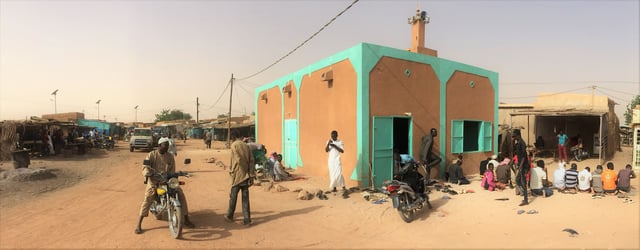
Small mosque in Filingue
The majority of Muslims in Niger are Sunni, 7% are Shi'a, 5% are Ahmadiyya and 20% non-denominational.[53][54] Islam was spread into what is now Niger beginning in the 15th century, by both the expansion of the Songhai Empire in the west, and the influence of the Trans-Saharan trade traveling from the Maghreb and Egypt. Tuareg expansion from the north, culminating in their seizure of the far eastern oases from the Kanem-Bornu Empire in the 17th centuries, spread distinctively Berber practices.
Both Zarma and Hausa areas were greatly influenced by the 18th- and 19th-century Fula led Sufi brotherhoods, most notably the Sokoto Caliphate (in today's Nigeria). Modern Muslim practice in Niger is often tied to the Tijaniya Sufi brotherhoods, although there are small minority groups tied to Hammallism and Nyassist Sufi orders in the west, and the Sanusiya in the far northeast.[52]
Despite this, Niger maintains a tradition as a secular state, protected by law.[59] Interfaith relations are deemed very good, and the forms of Islam traditionally practiced in most of the country are marked by tolerance of other faiths and lack of restrictions on personal freedom.[60] Divorce and polygyny are unremarkable, women are not secluded, and head coverings are not mandatory—they are often a rarity in urban areas.[61] Alcohol, such as the locally produced Bière Niger, is sold openly in most of the country.
Education
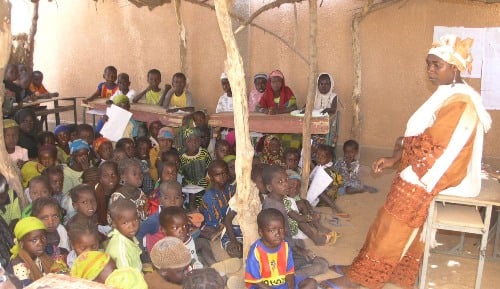
A primary classroom in Niger.
The literacy rate of Niger is among the lowest in the world; in 2005 it was estimated to be only 28.7% (42.9% male and 15.1% female).[28] Primary education in Niger is compulsory for six years.[63] The primary school enrollment and attendance rates are low, particularly for girls.[63] In 1997, the gross primary enrollment rate was 29.3 percent, and in 1996, the net primary enrollment rate was 24.5 percent.[63]
About 60 percent of children who finish primary schools are boys, as the majority of girls rarely attend school for more than a few years.[63] Children are often forced to work rather than attend school, particularly during planting or harvest periods.[63] Nomadic children in the north of the country often do not have access to schools.[63]
Health
The child mortality rate in Niger (deaths among children between the ages of 1 and 4) is high (248 per 1,000) due to generally poor health conditions and inadequate nutrition for most of the country's children.
According to the organization Save the Children, Niger has the world's highest infant mortality rate.[64]
Niger also has the highest fertility rate in the world (6.49 births per woman according to 2017 estimates[65]); this means that nearly half (49%) of the Nigerien population is under age 15. Niger has the 11th highest maternal mortality rate in the world at 820 deaths/100,000 live births. There were 3 physicians and 22 nurses per 100,000 persons in 2006.[67]
Culture

Horsemen at the traditional Ramadan festival at the Sultan's Palace in the Hausa city of Zinder.
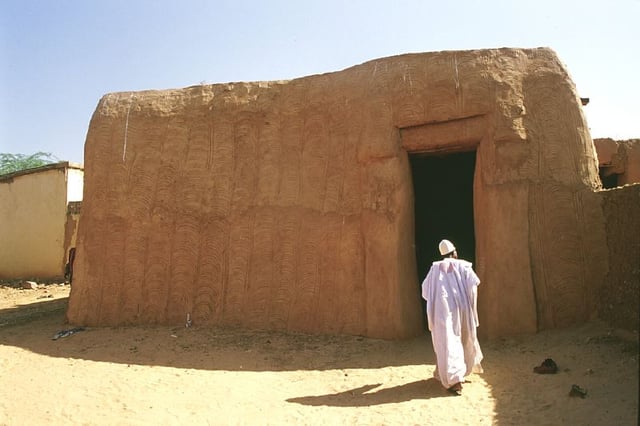
A traditional home in Zinder.
Nigerien culture is marked by variation, evidence of the cultural crossroads which French colonialism formed into a unified state from the beginning of the 20th century. What is now Niger was created from four distinct cultural areas in the pre-colonial era: the Zarma dominated Niger River valley in the southwest; the northern periphery of Hausaland, made mostly of those states which had resisted the Sokoto Caliphate, and ranged along the long southern border with Nigeria; the Lake Chad basin and Kaouar in the far east, populated by Kanuri farmers and Toubou pastoralists who had once been part of the Kanem-Bornu Empire; and the Tuareg nomads of the Aïr Mountains and Saharan desert in the vast north.
Each of these communities, along with smaller ethnic groups like the pastoral Wodaabe Fula, brought their own cultural traditions to the new state of Niger. While successive post-independence governments have tried to forge a shared national culture, this has been slow forming, in part because the major Nigerien communities have their own cultural histories, and in part because Nigerien ethnic groups such as the Hausa, Tuareg and Kanuri are but part of larger ethnic communities which cross borders introduced under colonialism.
Until the 1990s, government and politics was inordinately dominated by Niamey and the Zarma people of the surrounding region. At the same time the plurality of the population, in the Hausa borderlands between Birni-N'Konni and Maine-Soroa, have often looked culturally more to Hausaland in Nigeria than Niamey. Between 1996 and 2003, primary school attendance was around 30%,[68] including 36% of males and only 25% of females. Additional education occurs through madrasas.
Festivals and cultural events
Guérewol festival
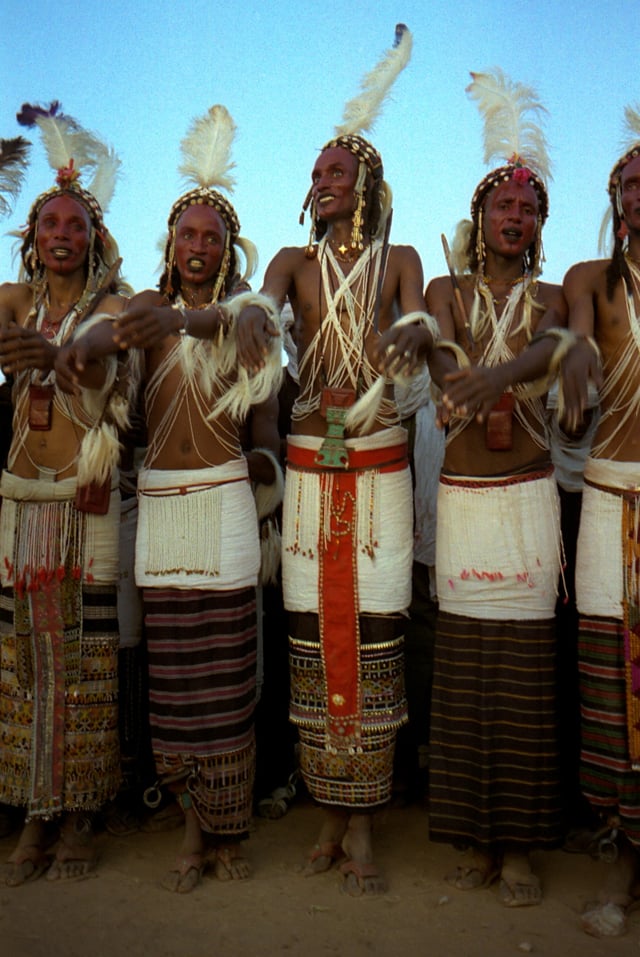
Participants in the Guérewol perform the Guérewol dance, 1997.
The Guérewol festival is a traditional Wodaabe cultural event that takes place in Abalak in Tahoua region or In'Gall in Agadez Region. It is an annual traditional courtship ritual practiced by the Wodaabe (Fula) people of Niger. During this ceremony, young men dressed in elaborate ornamentation and made up in traditional face painting gather in lines to dance and sing, vying for the attention of marriageable young women. The Guérewol festival is an international attraction and was featured in films and magazines as prominent as the National Geographic.
Cure Salée festival
"La Cure salée" (English: Salt Cure) is a yearly festival of Tuareg and Wodaabe nomads in In'Gall in Agadez Region traditionally to celebrate the end of the rainy season. For three days, the festival features a parade of Tuareg camel riders followed with camel and horse races, songs, dances, and storytelling.
Media
Niger began developing diverse media in the late 1990s.
Prior to the Third Republic, Nigeriens only had access to tightly controlled state media.[69] Now Niamey contains scores of newspapers and magazines; some, like Le Sahel, are government operated, while many are critical of the government.[70][71] Radio is the most important medium, as television sets are beyond the buying power of many of the rural poor, and illiteracy prevents print media from becoming a mass medium.[29]
In addition to the national and regional radio services of the state broadcaster ORTN, there are four privately owned radio networks which total more than 100 stations. Three of them—the Anfani Group, Sarounia and Tenere—are urban-based commercial-format FM networks in the major towns.[72] There is also a network of over 80 community radio stations spread across all seven regions of the country, governed by the Comité de Pilotage de Radios de Proximité (CPRP), a civil society organisation. The independent-sector radio networks are collectively estimated by CPRP officials to cover some 7.6 million people, or about 73% of the population (2005).
Aside from Nigerien radio stations, the BBC's Hausa service is listened to on FM repeaters across wide parts of the country, particularly in the south, close to the border with Nigeria. Radio France Internationale also rebroadcasts in French through some of the commercial stations, via satellite. Tenere FM also runs a national independent television station of the same name.[72]
Despite relative freedom at the national level, Nigerien journalists say they are often pressured by local authorities.[73] The state ORTN network depends financially on the government, partly through a surcharge on electricity bills, and partly through direct subsidy. The sector is governed by the Conseil Supérieur de Communications, established as an independent body in the early 1990s, since 2007 headed by Daouda Diallo. International human rights groups have criticised the government since at least 1996 as using regulation and police to punish criticism of the state.[74][75]
See also
Outline of Niger